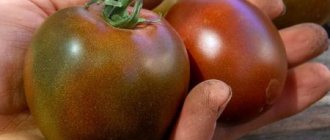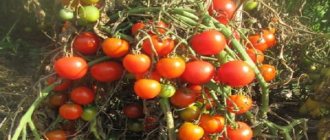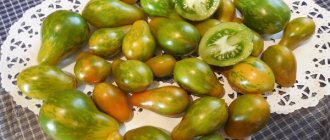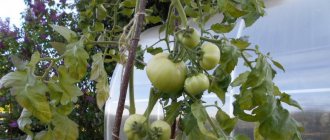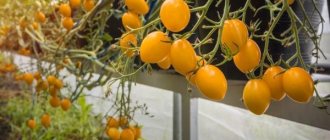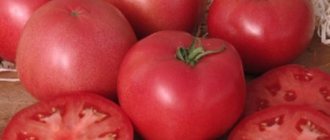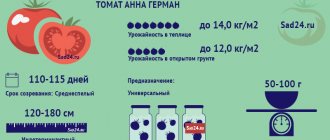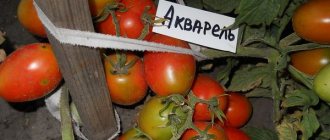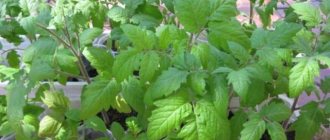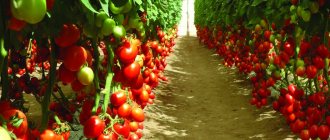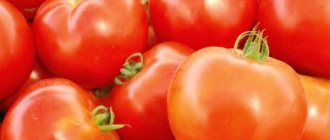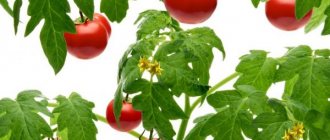| Ripening period: | average, 115-123 days |
| Shape, weight of fruits: | flat-round, 0.2-0.4 kg |
| Bush type: | semi-determinate |
| Growing regions: | the entire territory of Russia |
| Productivity: | up to 6 kg per plant |
Tomatoes of unusual colors always stand out against the background of red varieties. In addition to being attractive, the Chocolate Tomato has a bright sweet taste, which sets the vegetable apart from its competitors. Plants obtained as a result of Russian selection quickly adapt to the local climate, show high productivity and have their own advantages.
Description and characteristics of the variety
The Chocolate tomato variety was bred by researcher Lyubov Myazina. Throughout her practical activities, the breeder has created a whole list of unique crops. In 2005, the agricultural company Aelita (Moscow) submitted an application to register the variety. She is now a wholesaler of seeds of this variety. In 2007, the Chocolate variety was included in the State Register of the Russian Federation.
- This variety was created for cultivation in a greenhouse and in open ground.
- Ripening period is mid-early. Tomatoes can be harvested 110 days after the seeds have sprouted.
- In regions with cold climates, tomatoes are grown in greenhouses and greenhouses. In this case, the plant produces much more fruit per season.
- The tomato bush is of the semi-determinate type, not standard. Its stems can reach a height of 1.2 to 1.5 m. At the end of growth, a flower tassel is formed at the top of the plant.
- The stem itself is quite strong and thick. The leaves are dark green. Bushes of this variety need additional support.
- Bushes usually form 1-2 stems.
- The first flower cluster appears above the 8th leaf. Up to 5 fruits are formed on the resulting clusters.
- The plant has a powerful root system that grows in all directions. The bush does not grow a thick green mass, but the leaves are wide and cover the fruits.
- Tomatoes have an important feature: resistance to various forms of rot even in the wettest summer. Despite this, it is recommended not to neglect preventive measures. In hot weather and high humidity, planting that is too thick can become infected with late blight.
- Productivity is high. Almost 10 kg of tomatoes are harvested from 1 square meter. Under favorable weather conditions and proper care, the yield increases to 15 kg per 1 square meter.
- Cold summers slow down the growth of bushes and can also affect fruit yields.
Important! At low air temperatures, bushes slow down their development.
Comparison with other “chocolate” varieties
The Chocolate tomato is not the only variety that bears brown tomatoes. Several varieties even contain this word in their name. Thus, the Chocolate hybrid produces small fruits of good taste, and the Chocolate Apples variety bears small tomatoes, the taste of which is rated excellent.
In 2021, three varieties with similar names were registered in the State Register of Breeding Achievements of the Russian Federation: Chocolate Hare, Chocolate Gingerbread and Chocolate Banana. The first two fruits have an excellent taste, the banana has a good taste, but it has a very high yield. The declared yield of the Chocolate Hare is also twice as high as that of the Chocolate variety. All these varieties can be grown in any climatic regions.
Fruit characteristics
- Ripe tomatoes have a beautiful dark red color, almost brown. The surface of the fruit resembles the color of chocolate.
- Inside the fruit, the flesh is red, the color of the walls and chambers for seeds alternates: chocolate and light green.
- The average weight of one fruit is about 200 g, some specimens reach a weight of 400 g.
- Tomatoes are spherical in shape, and the upper and lower parts are slightly flattened.
- The excellent taste of the vegetable, to which no one will remain indifferent.
- The fruit is endowed with 4 seed chambers, but there are more.
- Tomatoes of this variety cannot be stored for a long time. After harvesting the fruits, they must be processed immediately.
Important! Tomatoes are picked only when ripe, as unripe ones do not ripen well indoors.
- Tomatoes withstand transportation well.
Advantages and disadvantages
- Tomatoes have good resistance to many diseases.
- Under favorable conditions it produces excellent fruit yields.
- Tomatoes have sizes that are convenient for preservation. Because the fruits are easy to pick from the bush, harvesting is quick and easy.
- Tomatoes of this variety have excellent taste.
- The Chocolate tomato variety is easy to care for.
- The fruits are marketable, so they can be grown for further sale.
In reviews of the Chocolate variety there are only positive statements, but there is no information about the shortcomings. Some vegetable growers, accustomed to red tomatoes, do not immediately get used to this color of tomatoes. But, thanks to the unique properties of the Chocolate variety of tomato, they soon change their minds.
Reviews of the Chocolate variety tomato
I really liked the variety, it fully corresponded to the description. The tomatoes are delicious and sweet. The variety is productive.
Stall
https://www.tomat-pomidor.com/forums/topic/1913-%D1%88%D0%BE%D0%BA%D0%BE%D0%BB%D0%B0%D0%B4%D0%BD %D1%8B%D0%B9/
The chocolate one was the first to bloom and the first to start knitting. I just don’t understand how to plant it, it produces flowering tassels through the leaf, the stepson just comes out, and there is already a brush on it and it blooms very quickly.
Kae-2
https://www.tomat-pomidor.com/forums/topic/1913-%D1%88%D0%BE%D0%BA%D0%BE%D0%BB%D0%B0%D0%B4%D0%BD %D1%8B%D0%B9/
We just grow Chocolate. The taste is much inferior to both the Black Prince and Paul Robeson. These are both significantly sweeter, and in appearance they do not have a red tint on the face. I sent all the Chocolate for ketchup.
Gost385147
https://www.forumhouse.ru/threads/149714/page-17
I purchased the Chocolate variety out of a passionate love for dark tomatoes. During this summer time, I started working on the greenhouse for the purpose of experimenting and now I know well which varieties to choose for it. And before that I took packets of seeds, which was probably original in appearance. So, I had the least amount of Chocolate bushes, because I lost the seedlings somewhere. When they started telling me that some tomatoes with green flesh were simply incredible, I decided that it was something unripe. Then I examined it and found such cute scarlet inclusions in the pulp. And I took a bite... It was so tasty, such a delicate and soft taste, that it didn’t even seem like a tomato to me at all!
lars001
https://otzovik.com/review_3661069.html
The Chocolate tomato is unusual in its appearance, but its fruits are very tasty and live up to the name. It is not difficult to grow this variety in all regions, and mainly in unprotected soil.
photo by Maya Zhuravel
Features of cultivation
This variety of tomatoes is intended for growing not only in a greenhouse, but also in open ground. It is important that the seedlings are healthy and strong. Tomato seeds are sown in late February - early March, depending on the location of the region and weather conditions in it. Remember that return frosts end in May in some regions and in early June in others.
Important! At the time of planting, the seedlings must be more than 50 days old.
Count 50 days from the planned date of planting seedlings, add another 5-7 days for seed germination and the same amount for picking, since after this procedure the seedlings stop growing.
The finished substrate is laid out in trays and watered with a spray bottle. Holes are made in the ground 1.5 cm deep, with a distance between them of at least 2 cm, and about 3 cm are left between the rows. Seeds are placed in each hole and covered with a loose mixture. Water the crops very carefully. The trays are covered with film or glass and kept warm at an air temperature of about 20-25 degrees.
Important! At lower temperatures, the seeds will take a long time to germinate and may die.
After germination, the coating is removed and the room temperature is lowered 5 degrees lower. Now for seedlings it is necessary to create the correct lighting and ensure that the soil in the pots does not dry out. As soon as the first 2-3 true leaves appear on the sprouts, you can begin to dive into separate containers with a volume of 400–500 ml.
10–14 days after picking, the seedlings are fertilized with fertilizers containing nitrogen (urea, ammonium nitrate, organic infusion) or complex fertilizer.
The seed manufacturer recommends using Aelita-vegetable for tomatoes for feeding.
Gardeners often use Fertika Lux. It is sold in almost any garden store.
Important! By the time of planting, the bush should have 6–7 strong leaves and at least 1 inflorescence.
Before planting tomatoes in a permanent place, they need to be hardened off. For 14 days, the seedlings are taken out into fresh air, gradually increasing the time.
The plant begins to be planted at the end of May. In this case, it is recommended to choose a warm, but not sunny day. Chocolate tomatoes are placed 3 plants per 1 square meter to prevent excessive planting density. Plant according to the pattern 70x50 cm or 80x40 cm.
The bushes are formed into 1–2 stems, but Lyubov Myazina still recommends leaving only 1 stem and removing all the stepsons. The number of brushes left is the amount that will have time to ripen in a particular region. The top should be pinched 30 days before it gets cold in the morning.
The rest of the care for this variety is the same as for other tomatoes:
- Water when the leaves hang slightly at the bottom of the bush.
- After watering, the soil around the stem must be loosened and covered with mulch.
- Apply fertilizer for tomatoes once every 2 weeks. The best way to feed tomatoes can be found in the article...
- Remove growing stepsons.
- Tie the stem as it grows.
More information about growing tomatoes is described in the article: Technology of growing tomatoes. Secrets of planting and care
You might be interested in: How to properly plant tomatoes in a greenhouse: bush formation diagram, care features, photos and videos
Useful information: How to properly tie tomatoes in open ground: the best methods, step-by-step photo and video instructions
Recommendation for tomato care
With proper care of tomatoes, you can significantly increase productivity. Particular attention should be paid to watering and fertilizing the soil.
Watering
Tomatoes do not need frequent watering. If the soil is constantly waterlogged, the fruits will grow watery and tasteless. It is enough to irrigate the beds 2-3 times a week. Watering is carried out in the evenings with heated water. If you irrigate the soil with ice water, the risk of developing fungal diseases will increase.
Top dressing
Tomatoes need nutrients added to the soil. In the first half of the season, when the bushes are actively growing, nitrogen is added to the soil. Nitrogen-containing fertilizers activate growth, and tomatoes begin to bear fruit faster. Ammonium sulfate, urea, and sodium nitrate are used as fertilizers.
After the tomatoes begin to bloom, they stop adding nitrogen to the soil and begin to feed the plants with potassium and phosphorus. These fertilizers have a positive effect on the formation of ovaries and improve the taste of tomatoes.
In addition to mineral fertilizers, the bushes are also fed with organic fertilizers. For example, you can water the beds with an infusion of weeds or sprinkle the beds with wood ash, and then water the beds. Another recipe for organic fertilizing is watering the beds with an infusion of banana peels. Banana peels are filled with water and placed in a dark place to ferment for 7 days. Before watering, the fertilizer is diluted in water.
When applying fertilizing, you need to pay attention to the appearance of the bushes. If plants are actively growing leaf mass, it means they are overfed. In this case, the application of fertilizers is stopped.
Stepsoning
Tomato bushes need to be pinched. This variety is tall, so the lower branches need to be cut off as they grow. They are of no use, and they take nutrients from the bush. Stepchildren tear them off with their hands, but it is better to cut them off with garden shears.
See also
Why leaves of tomato seedlings may wither and curl and what to do
Read
Mulching
Another measure that can be used to increase productivity is mulching the beds. Peat, sawdust or special agrofibre are used as mulch. The mulch layer should not be less than 15 cm. Thanks to mulching, there is no need to weed the soil, remove weeds and frequently water the beds.
Weeding
Once a week before watering, you should weed the soil and remove all weeds from the area. There is no need to weed the soil deeply, 7-10 cm is enough. After weeding, the root system is also saturated with oxygen, so the bushes begin to grow and bear fruit more actively.
Garter bushes
Tall tomato bushes need staking. If this is not done, the stems will break under the weight of the fruit. Plants are tied up at the beginning of the growing season, when the bushes grow relatively tall.
Protection of crops from diseases and pests
Although the Chocolate tomato variety is disease-resistant, extra prevention won’t hurt.
Preventive measures against pests and diseases:
- It is not recommended to plant tomatoes close to each other.
- Weeds should be destroyed regularly and prevented from appearing on the site. Weeds cause not only diseases but also pests on crops.
- Do not water the beds with cold water or flood the tomatoes.
- Don't forget about fertilizing. In poor soil, tomatoes grow poorly and their immunity is weak.
Common tomato diseases include:
- Tobacco mosaic. The first sign is the appearance of yellow spots on the foliage. They then curl and become wrinkled. There is no cure for this disease. Affected bushes are dug up and destroyed. The soil is then watered with a solution of potassium permanganate. As a preventative measure, seeds are treated before sowing.
- Late blight. Often in hot and humid weather, bushes begin to develop late blight. Most often, late blight occurs when grown in open ground. A characteristic sign is the appearance of dark spots on the fruit. Spraying with the preparation “Zaslon” or “Barrier” helps against late blight.
Among the insects, you can find slugs on tomatoes, especially if cabbage grows next to the beds. Another pest is the cutworm. These are small caterpillars of different colors. You can get rid of pests if you treat the bushes with Strela. Also, after harvesting, the soil is dug up to 20 cm.
